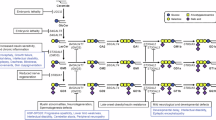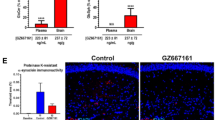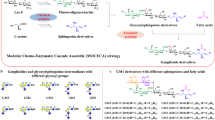Abstract
We identified an autosomal recessive infantile-onset symptomatic epilepsy syndrome associated with developmental stagnation and blindness. Assuming a founder effect in a large Old Order Amish pedigree, we carried out a genome-wide screen for linkage and identified a single region of homozygosity on chromosome 2p12–p11.2 spanning 5.1 cM (maximum lod score of 6.84). We sequenced genes in the region and identified a nonsense mutation in SIAT9, which is predicted to result in the premature termination of the GM3 synthase enzyme (also called lactosylceramide α-2,3 sialyltransferase). GM3 synthase is a member of the sialyltransferase family and catalyzes the initial step in the biosynthesis of most complex gangliosides from lactosylceramide. Biochemical analysis of plasma glycosphingolipids confirmed that affected individuals lack GM3 synthase activity, as marked by a complete lack of GM3 ganglioside and its biosynthetic derivatives and an increase in lactosylceramide and its alternative derivatives. Although the relationship between defects in ganglioside catabolism and a range of lysosomal storage diseases is well documented, this is the first report, to our knowledge, of a disruption of ganglioside biosynthesis associated with human disease.
This is a preview of subscription content, access via your institution
Access options
Subscribe to this journal
Receive 12 print issues and online access
$259.00 per year
only $21.58 per issue
Buy this article
- Purchase on SpringerLink
- Instant access to full article PDF
Prices may be subject to local taxes which are calculated during checkout




Similar content being viewed by others
Accession codes
References
Gardiner, R.M. Impact of our understanding of the genetic aetiology of epilepsy. J. Neurol. 247, 327–334 (2000).
Datta, A.K., Chammas, R. & Paulson, J.C. Conserved cysteines in the sialyltransferase sialylmotifs form an essential disulfide bond. J. Biol. Chem 276, 15200–15207 (2001).
Neville, D.C.A. et al. Analysis of fluorescently labelled glycosphingolipid-derived oligosaccharides following ceramide glycanase digestion and anthranilic acid labelling. Anal. Biochem. 331, 275–282 (2004).
Kundu, S.K., Diego, I., Osovitz, S. & Marcus, D.M. Glycosphingolipids of human plasma. Arch. Biochem. Biophys. 238, 388–400 (1985).
Senn, H.J. et al. Human serum gangliosides in hypercholesterolemia, before and after extracorporeal elimination of LDL. Atherosclerosis 94, 109–117 (1992).
Negroni, E., Chigorno, V., Tettamanti, G. & Sonnino, S. Evaluation of the efficiency of an assay procedure for gangliosides in human serum. Glycoconj. J. 13, 347–352 (1996).
Zeller, C.B. & Marchase, R.B. Gangliosides as modulators of cell function. Am. J. Physiol 262, C1341–C1355 (1992).
Hakomori, S. Traveling for the glycosphingolipid path. Glycoconj. J. 17, 627–647 (2000).
Kobayashi, T. & Hirabayashi, Y. Lipid membrane domains in cell surface and vacuolar systems. Glycoconj. J. 17, 163–171 (2000).
Munro, S. Lipid rafts: elusive or illusive? Cell 115, 377–388 (2003).
Sandhoff, K. & Kolter, T. Biosynthesis and degradation of mammalian glycosphingolipids. Philos. Trans. R. Soc. Lond. B Biol. Sci. 358, 847–861 (2003).
Schapiro, F.B., Lingwood, C., Furuya, W. & Grinstein, S. pH-independent retrograde targeting of glycolipids to the Golgi complex. Am. J. Physiol 274, C319–C332 (1998).
Wraith, J.E. Lysosomal disorders. Semin. Neonatol. 7, 75–83 (2002).
Max, S.R. et al. GM3 (hematoside) sphingolipodystrophy. N. Engl. J. Med. 291, 929–31 (1974).
Zebda, N., Pedron, S., Rebbaa, A., Portoukalian, J. & Berthier-Vergnes, O. Deficiency of ganglioside biosynthesis in metastatic human melanoma cells: relevance of CMP-NeuAc:LacCer alpha 2-3 sialyltransferase (GM3 synthase). FEBS Lett. 362, 161–164 (1995).
Yamashita, T. et al. Enhanced insulin sensitivity in mice lacking ganglioside GM3. Proc. Natl. Acad. Sci. USA 100, 3445–3449 (2003).
Kawai, H. et al. Mice expressing only monosialoganglioside GM3 exhibit lethal audiogenic seizures. J. Biol. Chem. 276, 6885–6888 (2001).
Inoue, M. et al. Refractory skin injury in complex knock-out mice expressing only the GM3 ganglioside. J. Biol. Chem. 277, 29881–29888 (2002).
Proia, R.L. Glycosphingolipid functions: insights from engineered mouse models. Philos. Trans. R. Soc. Lond. B Biol. Sci. 358, 879–883 (2003).
Yu, R.K. & Glaser, G.H. Possible role of gangliosides in epilepsy: effects of epileptic seizures on cerebral gangliosides. Trans. Am. Neurol. Assoc. 100, 261–263 (1975).
Yu, R.K., Holley, J.A., Macala, L.J. & Spencer, D.D. Ganglioside changes associated with temporal lobe epilepsy in the human hippocampus. Yale J. Biol. Med. 60, 107–117 (1987).
Izumi, T., Ogawa, T., Koizumi, H. & Fukuyama, Y. Low levels of CSF gangliotetraose-series gangliosides in West syndrome: implication of brain maturation disturbance. Pediatr. Neurol. 9, 293–296 (1993).
Acknowledgements
We thank the Amish families for their help and support and the Das Deutsch Centre for facilitating contact with the affected individuals. This work was supported by The Birth Defects Foundation UK, The Wellcome Trust and Research to Prevent Blindness.
Author information
Authors and Affiliations
Corresponding author
Ethics declarations
Competing interests
The authors declare no competing financial interests.
Rights and permissions
About this article
Cite this article
Simpson, M., Cross, H., Proukakis, C. et al. Infantile-onset symptomatic epilepsy syndrome caused by a homozygous loss-of-function mutation of GM3 synthase. Nat Genet 36, 1225–1229 (2004). https://doi.org/10.1038/ng1460
Received:
Accepted:
Published:
Issue date:
DOI: https://doi.org/10.1038/ng1460
This article is cited by
-
Glucosylceramide synthase inhibition reduces ganglioside GM3 accumulation, alleviates amyloid neuropathology, and stabilizes remote contextual memory in a mouse model of Alzheimer’s disease
Alzheimer's Research & Therapy (2022)
-
Anti-inflammatory role of GM1 and other gangliosides on microglia
Journal of Neuroinflammation (2022)



